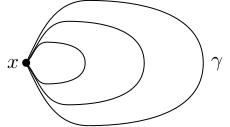If is a homomorphism of Lie groups then there exists a linear map which is a Lie algebra homomorphism (i.e. ) such that for all .
Lie's theorem on homomorphisms
Exponentiating homomorphisms
Last time we proved the following theorem.
What about the other direction? If we're given a Lie algebra homomorphism , can we find a Lie group homomorphism such that ?
Take . Then so, for any smooth homomorphism we get . Since is linear and is 1-dimensional, for some .
The Lie bracket on is trivial: , so automatically preserves the bracket. Therefore any defines for us a Lie algebra homomorphism , .
So any homomorphism has the form for some . Which can occur? Not all of them. For to be well-defined, we need (because ) so we need and hence we need . Conversely, if then is well-defined: it's just raising to the (integer) power .
So not every Lie algebra homomorphism can be exponentiated to get a Lie group homomorphism: can be exponentiated if and only if .
This example is sufficiently important to summarise as a lemma:
The maps , , are homomorphisms and every smooth homomorphism is one of these.
The integers come into this example because the group has some interesting topology. is a circle, so loops in have a winding number that counts how many times they go around the circle. The in the lemma is related to this integer winding number.
Simply-connectedness
There is a topological condition you can put on to ensure that any Lie algebra homomorphism exponentiates.
Let be a simply-connected matrix group and any matrix group. Then for every Lie algebra homomorphism there exists a smooth group homomorphism such that .
We will not prove this theorem: it's a gorgeous proof and would make an excellent project!
A space
is called
A loop in is a continuous map such that . You should think of as a parametrised path with parameter , which starts and ends at the same point. If is a matrix group then continuity here means that the matrix entries of depend continuously on .
A nullhomotopy of a loop is a continuous map (which we can think of as a family of loops ) such that:
-
these loops all start and end at the same point (so for all .
-
is our loop
-
is the constant loop .
In other words, starts being and gradually shrinks down to a constant loop.

The circle is certainly not simply-connected, but there are plenty of groups which are simply-connected. There is an optional video which talks more about the topology of the groups we've been meeting which will give a vague explanation for why the groups are simply-connected. I also have some videos about topology, simply-connectedness and the fundamental group if you want to learn more about this (you could do a project about the topology of Lie groups).